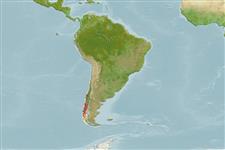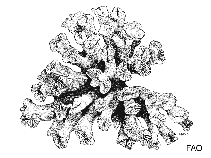Tethocyathus endesa Cairns, Haeussermann & Foersterra, 2005
Endesa saucer coral| Native range | All suitable habitat | Point map | Year 2050 |

|
| This map was computer-generated and has not yet been reviewed. |
| Tethocyathus endesa AquaMaps Data sources: GBIF OBIS |
Upload your photos
Google image | No image available for this species;
drawing shows typical species in Caryophylliidae.
Google image | No image available for this species;
drawing shows typical species in Caryophylliidae.
Classification / Names Common names | Synonyms | CoL | ITIS | WoRMS
Anthozoa | Scleractinia | Caryophylliidae
Environment: milieu / climate zone / depth range / distribution range Ecology
Sessile; depth range 11 - 200 m (Ref. 87801). Subtropical
Distribution Countries | FAO areas | Ecosystems | Occurrences | Introductions
Southeast Pacific: Probably endemic to Chile.
Length at first maturity / Size / Weight / Age
Maturity: Lm ? range ? - ? cm
This species is found on hard substrates in crevices and caverns at depths of 11 to 200 m. It is often mixed with Epizoanthus fiodicus (Ref. 87801).
Life cycle and mating behavior Maturity | Reproduction | Spawning | Eggs | Fecundity | Larvae
Members of the class Anthozoa are either gonochoric or hermaphroditic. Mature gametes are shed into the coelenteron and spawned through the mouth. Life cycle: The zygote develops into a planktonic planula larva. Metamorphosis begins with early morphogenesis of tentacles, septa and pharynx before larval settlement on the aboral end.
Main reference
References | Coordinator | Collaborators
Häussermann, V. and G. Försterra. 2009. (Ref. 87801)
IUCN Red List Status (Ref. 130435)
CITES status (Ref. 108899)
Appendix II: International trade monitored
CMS (Ref. 116361)
Not Evaluated
Threat to humans
Harmless
Human uses
| FishSource |
Tools
More information
Age/Size
Growth
Length-weight
Length-length
Morphology
Larvae
Abundance
Growth
Length-weight
Length-length
Morphology
Larvae
Abundance
Internet sources
BHL | BOLD Systems | CISTI | DiscoverLife | FAO(Publication : search) | Fishipedia | GenBank (genome, nucleotide) | GloBI | Gomexsi | Google Books | Google Scholar | Google | PubMed | Hexacorallians of the World | Tree of Life | Wikipedia (Go, Search) | Zoological Record
Estimates based on models
Preferred temperature
(Ref. 115969): 9.9 - 13.7, mean 11.5 (based on 30 cells).



